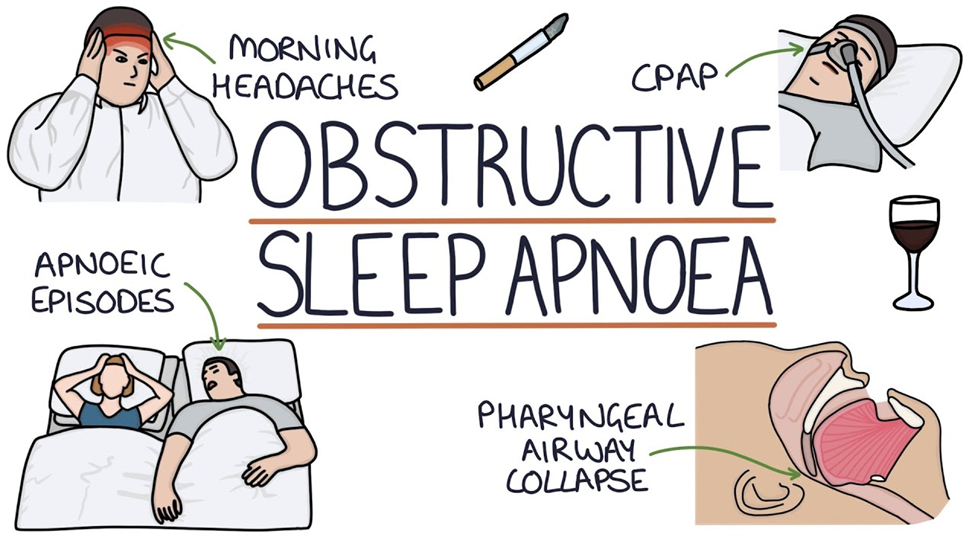A nurse is collecting data on a client who has obstructive sleep apnea. Which of the following findings should the nurse expect?
Constipation
Nausea
Headache
Hypotension
The Correct Answer is C
A. Constipation
Constipation is not typically associated with obstructive sleep apnea. However, sleep disturbances and certain medications used to manage OSA may indirectly contribute to constipation in some cases.
B. Nausea
Nausea is not a common symptom of obstructive sleep apnea. While sleep disturbances may affect gastrointestinal function in some individuals, nausea is not a typical manifestation of OSA.
C. Headache
One of the common findings associated with obstructive sleep apnea (OSA) is headache. This occurs due to the repeated episodes of apnea (cessation of breathing) during sleep, which leads to intermittent hypoxia (low oxygen levels) and subsequent cerebral vasodilation. The vasodilation can trigger headaches, often described as morning headaches, upon waking up. These headaches are typically frontal and may be accompanied by other symptoms such as fatigue and irritability.
D. Hypotension
Hypotension (low blood pressure) is not a typical finding in obstructive sleep apnea. In fact, individuals with OSA are more likely to have hypertension (high blood pressure) due to the effects of repeated apnea episodes on the cardiovascular system, such as increased sympathetic activity and arterial stiffness.

Nursing Test Bank
Naxlex Comprehensive Predictor Exams
Related Questions
Correct Answer is C
Explanation
A. Nausea
While nausea can occur in hypoxia, it is less common compared to other symptoms such as dyspnea (difficulty breathing), confusion, or cyanosis (bluish discoloration of the skin and mucous membranes).
B. Dysphagia
Dysphagia, or difficulty swallowing, is not typically associated with hypoxia. It is more commonly seen in conditions affecting the esophagus or neurological disorders affecting swallowing function.
C. Agitation
Manifestations of hypoxia can vary depending on the severity and duration of oxygen deprivation. Agitation is a common finding in hypoxia, particularly in cases of acute or severe hypoxemia. As the body's oxygen supply becomes compromised, the brain may perceive this as a threat, leading to increased anxiety, restlessness, and agitation as the body attempts to compensate for the lack of oxygen.
D. Warm, dry skin
Warm, dry skin is not a typical finding in hypoxia. Instead, hypoxia may lead to peripheral vasoconstriction and cool, clammy skin as the body attempts to conserve oxygen and maintain core body temperature.
Correct Answer is A
Explanation
A. Withhold food and liquids until the client's gag reflex returns.
This is the correct action. After a bronchoscopy, the client's throat may be numb or irritated from the procedure, which can temporarily impair the gag reflex. Withholding food and liquids until the gag reflex returns reduces the risk of aspiration, where food or liquid enters the airway instead of the stomach. Aspiration can lead to pneumonia and other serious complications. Therefore, it's essential to assess the client's gag reflex before allowing them to eat or drink.
B. Irrigate the client's throat every 4 hours.
This action is not necessary and may even be harmful. Irrigating the client's throat every 4 hours could further irritate the throat and increase discomfort for the client. Unless specifically ordered by the healthcare provider for a specific reason, such as to remove secretions or debris, routine irrigation of the throat is not recommended after a bronchoscopy.
C. Have the client refrain from talking for 24 hours.
There is typically no need for the client to refrain from talking for 24 hours after a bronchoscopy. While the client may experience some throat discomfort and hoarseness, restricting talking for such an extended period is unnecessary and may cause undue stress or anxiety for the client. Unless specifically instructed by the healthcare provider for a valid reason, such as to allow vocal cord healing, there is no need to restrict talking for such a long duration.
D. Suction the client's oropharynx frequently.
Frequent suctioning of the client's oropharynx is not indicated unless there is a specific medical reason to do so. Excessive suctioning can cause trauma to the mucous membranes, increase the risk of infection, and exacerbate throat irritation. The decision to suction should be based on clinical assessment, such as evidence of secretions or if the client is having difficulty clearing their airway, rather than being performed routinely.
Whether you are a student looking to ace your exams or a practicing nurse seeking to enhance your expertise , our nursing education contents will empower you with the confidence and competence to make a difference in the lives of patients and become a respected leader in the healthcare field.
Visit Naxlex, invest in your future and unlock endless possibilities with our unparalleled nursing education contents today
Report Wrong Answer on the Current Question
Do you disagree with the answer? If yes, what is your expected answer? Explain.
Kindly be descriptive with the issue you are facing.
